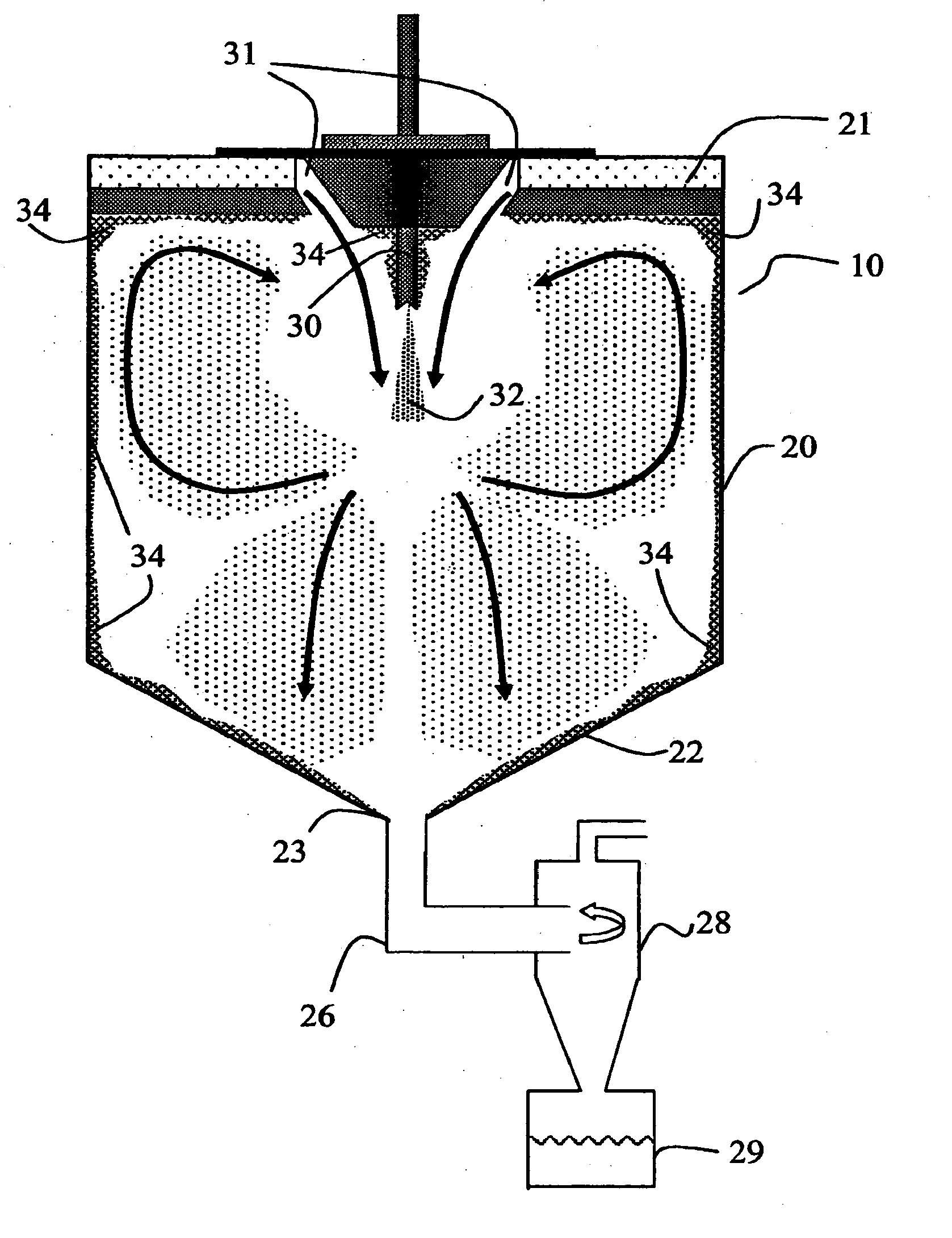Method for making homogeneous spray-dried solid amorphous drug dispersions utilizing modified spray-drying apparatus
a technology of spray-drying apparatus and dispersions, which is applied in the direction of lighting and heating apparatus, pharmaceutical product form changes, furniture, etc., can solve the problems of poor collection efficiency, poor flow characteristics of dispersions produced using spray-drying apparatus equipped with two-fluid nozzles, etc., and achieve the effect of facilitating the flow of drying gas through the plug
- Summary
- Abstract
- Description
- Claims
- Application Information
AI Technical Summary
Benefits of technology
Problems solved by technology
Method used
Image
Examples
example 1
[0116]A solid amorphous dispersion was prepared using a spray-drying apparatus of substantially the same configuration as that shown in FIG. 5. The dispersion comprised 25 wt % of the low-solubility drug 4-[(3,5-bis-trifluoromethyl-benzyl)-methoxycarbonyl-amino]-2-ethyl-6-trifluoromethyl-3,4-dihydro-2H-quinoline-1-carboxylic acid ethyl ester (“Drug 1”) and 75 wt % of the amphiphilic polymer hydroxypropyl methyl cellulose acetate succinate (HPMCAS). Drug 1 was mixed in a solvent (acetone) together with a “medium fine” grade (AQUOT-MF) of HPMCAS (manufactured by Shin Etsu) to form a spray solution. The spray solution comprised 2.5 wt % Drug 1, 7.5 wt % HPMCAS, and 90 wt % acetone. The spray solution was pumped using a high pressure pump (Z-Drive 2000 High Pressure Gear Pump from Zenith, Inc. of Sanford, N.C.) to a spray-dryer (Niro type XP Portable Spray-Dryer with a Liquid Feed Process Vessel Model No. PSD-1) equipped with a pressure nozzle (Spraying Systems Pressure Nozzle and Body,...
example 2
[0136]A solid amorphous dispersion was prepared as in Example 1 with the same spray-dryer configuration as in Example 1, except that the height of the drying chamber H was 2.3 m, resulting in a larger volume for the drying chamber. Thus, the volume of the spray-drying apparatus was 1.29 m3. Table 6 gives the spray-drying conditions used. Nitrogen drying gas was circulated through the gas-disperser plate at an inlet temperature of 45° C. and a flow rate of 1.4 standard m3 / min. The evaporated solvent and wet drying gas exited the spray-dryer at a temperature of 10° C.
[0137]Referring to Equation I above, the minimum residence time for the droplets in the spray drier was calculated as
τ=1.291.4=0.92min×60secmin=55sec.
TABLE 6DrugPolymerSolventNozzleFeedMassMassMassPressureRateTinToutYield(g)(g)(g)Nozzle(psig / atm)(g / min)(° C.)(° C.)(%)1504505400SK 80-16290 / 21206451088
[0138]Inspection of the spray-dryer after formation of the dispersion showed no evidence of product build up on the spray-dr...
example 3
[0141]A solid amorphous dispersion comprising 50 wt % of the low solubility drug 5-chloro-1H-indole-2-carboxylic acid [(1S)-benzyl-(2R)-hydroxy-3-((3R,4S)-dihydroxy-pyrrolidin-1-yl-)-3-oxypropyl]amide (“Drug 2”) with HPMCAS-MF was made using the spray-drying apparatus of Example 1 using a solvent comprising a mixture of 10 wt % water in acetone. The spray-drying conditions are given in Table 8. Nitrogen drying gas was delivered to the gas-disperser plate at an inlet temperature of 103° C. and a flow rate of 1.6 standard m3 / min. The evaporated solvent and drying gas exited the spray drier at a temperature of 51±4° C.
[0142]Referring to Equation I above, the minimum residence time for the droplets in the spray drier was calculated as
τ=0.651.6=0.41min×60secmin=24sec.
[0143]Inspection of the spray-dryer after formation of the dispersion showed no evidence of product build-up on the spray-dryer top, the pressure nozzle, the walls of the drying chamber or on the chamber cone.
[0144]Control 2...
PUM
| Property | Measurement | Unit |
|---|---|---|
| diameter | aaaaa | aaaaa |
| diameter | aaaaa | aaaaa |
| inlet temperature | aaaaa | aaaaa |
Abstract
Description
Claims
Application Information
 Login to View More
Login to View More - R&D
- Intellectual Property
- Life Sciences
- Materials
- Tech Scout
- Unparalleled Data Quality
- Higher Quality Content
- 60% Fewer Hallucinations
Browse by: Latest US Patents, China's latest patents, Technical Efficacy Thesaurus, Application Domain, Technology Topic, Popular Technical Reports.
© 2025 PatSnap. All rights reserved.Legal|Privacy policy|Modern Slavery Act Transparency Statement|Sitemap|About US| Contact US: help@patsnap.com



